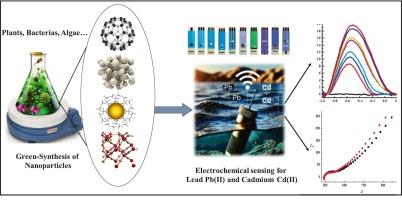Green-synthesized nanoparticle-enhanced electrochemical sensors for Pb and Cd ions detection
IF 4.9
2区 化学
Q1 CHEMISTRY, ANALYTICAL
引用次数: 0
Abstract
The widespread occurrence of toxic heavy metals, such as lead (Pb) and cadmium (Cd), poses a significant threat to both ecological and human health because of their high toxicity, persistence, and bioaccumulation. In response to the urgent need for sustainable and sensitive detection strategies, this review critically evaluates recent advances (2015–2025) in the green synthesis of nanoparticles (NPs) and their correlation with sensor performance. Nanoparticles synthesized via environmentally friendly routes using plant extracts, microbial systems, and natural polymers exhibit tunable physicochemical properties that enhance the sensitivity, selectivity, and detection limits of sensors. We examine the integration of these nanomaterials into electrochemical platforms, focusing on their structural features, synthesis mechanisms, and performance in heavy metal ion detection. Comparative insights into the synthesis approaches and NPs compositions are provided to elucidate the structure–function relationships that dictate the sensing behavior. We also discuss key challenges related to the scalability of green synthesis, electrode stability, and long-term reproducibility. This review concludes with perspectives on the future deployment of green-enabled sensors for real-time, on-site environmental monitoring, emphasizing their potential for sustainable, high-performance solutions in heavy metal detection.

绿色合成纳米粒子增强的铅、镉离子电化学传感器
铅(Pb)和镉(Cd)等有毒重金属的广泛存在,由于其高毒性、持久性和生物蓄积性,对生态和人类健康构成了重大威胁。为了响应可持续和敏感检测策略的迫切需要,本文对纳米颗粒(NPs)绿色合成的最新进展(2015-2025)及其与传感器性能的相关性进行了批判性评估。利用植物提取物、微生物系统和天然聚合物通过环保途径合成的纳米颗粒具有可调的物理化学性质,可提高传感器的灵敏度、选择性和检测限。我们研究了这些纳米材料与电化学平台的集成,重点研究了它们的结构特征、合成机制以及在重金属离子检测中的性能。提供了对合成方法和NPs组成的比较见解,以阐明决定传感行为的结构-功能关系。我们还讨论了与绿色合成的可扩展性、电极稳定性和长期可重复性相关的关键挑战。本文总结了绿色传感器用于实时、现场环境监测的未来部署,强调了它们在重金属检测中可持续、高性能解决方案的潜力。
本文章由计算机程序翻译,如有差异,请以英文原文为准。
求助全文
约1分钟内获得全文
求助全文
来源期刊

Microchemical Journal
化学-分析化学
CiteScore
8.70
自引率
8.30%
发文量
1131
审稿时长
1.9 months
期刊介绍:
The Microchemical Journal is a peer reviewed journal devoted to all aspects and phases of analytical chemistry and chemical analysis. The Microchemical Journal publishes articles which are at the forefront of modern analytical chemistry and cover innovations in the techniques to the finest possible limits. This includes fundamental aspects, instrumentation, new developments, innovative and novel methods and applications including environmental and clinical field.
Traditional classical analytical methods such as spectrophotometry and titrimetry as well as established instrumentation methods such as flame and graphite furnace atomic absorption spectrometry, gas chromatography, and modified glassy or carbon electrode electrochemical methods will be considered, provided they show significant improvements and novelty compared to the established methods.
 求助内容:
求助内容: 应助结果提醒方式:
应助结果提醒方式:


